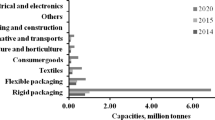Abstract
In the study, microencapsulation of methyl cedryl ketone (MCK) with polyurethane urea (PUU) polymers was performed by interfacial polymerization method. PUU (isocyanate/PEG-400/polyamine) mole ratios (5.4/3.0–5.5/1.5–3.9), which is the main component of the capsule shell, were formed at a temperature of 80 °C in 240 min. The encapsulation efficiency of the produced microencapsules, CMK-PUU microcapsule release at room temperature, microencapsule shell degradation at high temperature, adhesion durability by fixing on cotton, polyester, silk and non-woven fabric were investigated. Structure analysis of the toluenediisocyanate, non-containing MCK-PUU microencapsule shell in FT-IR spectroscopy, stability and size of emulsified droplets with optical microscope, the size, wall thickness and adhesion of the MCK-PUU microencapsules on the fabric by scanning electron microscope and thermal degradation of the capsule wall material by thermo gravimetric analysis were investigated. The yield of the microencapsules was 65.66–73.56%, the capsule wall thickness was 1250 nm, the active substance loss at 20 °C for 60 days was 5.5%, after being attached to the fabric, it was stable up to 4 washes on the fabric.












Similar content being viewed by others
Data Availability
All citations used in the text are given in the references section.
References
Abd Manaf M, Jai J, Raslan R, Subuki I, Mustapa AN (2015) Microencapsulation methods of volatile essential oils-a review. Adv Mater Res 1113:679–683
Abdelkader MB, Azizi N, Baffoun A, Chevalier Y, Majdoub M (2018) New microcapsules based on isosorbide for cosmetotextile: preparation and characterization. Ind Crops Prod 123:591–599
Ahangaran F, Navarchian AH, Picchioni F (2019) Material encapsulation in poly (methyl methacrylate) shell: a review. J Appl Polym Sci 136:48039
Alič B, Šebenik U, Krajnc M (2012) Microencapsulation of butyl stearate with melamineformaldehyde resin: effect of decreasing the pH value on the composition and thermal stability of microcapsules. Express Polym Lett 6:826–836
Barbosa-Cánovas GV, Ortega-Rivas E, Juliano P, Yan HJ (2005) Encapsulation processes. In: Ermis E (ed) Food powders. Food engineering series. Springer, Boston
Bastos F, Santos L (2015) Encapsulation of cosmetic active ingredients for topical application—A review. J Microencapsul 33:1–17
Bratovcic A, Suljagic J (2019) Micro-and nano-encapsulation in food industry. Croat J Food Sci Technol 11:113–121
Carvalho IT, Estevinho BN, Santos L (2016) Application of microencapsulated essential oils in cosmetic and personal healthcare products—A review. Int J Cos Sci 38:109–119
Cheng M, Wang J, Zhang R, Kong R, Lu W, Wang X (2019) Characterization and application of the microencapsulated carvacrol/sodium alginate films as food packaging materials. Int J Biol Macromol 141:259–267
Desai KGH, Jin-Park H (2005) Recent developments in microencapsulation of food ingredients. Dry technol 23:1361–1394
Dubey R, Shami TC, Bhasker-Rao KU (2009) Microencapsulation technology and applications. Def Sci J 59:82–95
Fan C, Zhou X (2011) Effect of emulsifier on poly (urea–formaldehyde) microencapsulation of tetrachloroethylene. Polym Bull 67:15–27
Han Q, Urban MW (2001) Surface/interfacial changes during polyurethane crosslinking: a spectroscopic study. J App Poly Sci 81:2045–2054
Li S, Lewis JE, Stewart NM, Qian L, Boyter H (2008) Effect of finishing methods on washing durability of microencapsulated aroma finishing. J Text Inst 99:177–183
Liao L, Zhang W, Zhao Y, Li W (2010) Preparation and characterization of microcapsules for self-healing materials. Chem Res Chin Univ 26:496–500
Liu F, Wang J, Qian X (2017) Integrating phase change materials into concrete through microencapsulation using cenospheres. Cem Concr Compos 80:317–325
Mačiulyte S, Gutauskiene G, Niedritis J, Kochane T, Budriene S (2017) PVA and various diisocyanates based poly (urethaneurea) microcapsules for encapsulation of enzyme in water/butyl acetate emulsion: synthesis and study. Chemija 28:74–84
Morgan PW, Kwolek SL (1959) Interfacial polycondensation. II. Fundamentals of polymer formation at liquid interfaces. J Poly Sci 40:299–327
Pena B, Panisello C, Areste G, Garcia-Valls R, Gumi T (2012) Preparation and characterization of polysulfone microcapsules for perfume release. Chem Eng J 179:394–403
Podshivalov AV, Bronnikov S, Zuev VV, Jiamrungraksa T, Charuchinda S (2013) Synthesis and characterization of polyurethane–urea microcapsules containing galangal essential oil: statistical analysis of encapsulation. J Microencapsul 30:198–203
Riaz T, Iqbal MW, Saeed M, Yasmin I, Hassanin HA, Mahmood S, Rehman A (2019) In vitro survival of Bifidobacterium bifidum microencapsulated in zein-coated alginate hydrogel microbeads. J Microencapsul 36:192–203
Ribeiro AM, Shahgol M, Estevinho BN, Rocha F (2020) Microencapsulation of vitamin A by spray-drying, using binary and ternary blends of gum Arabic, starch and maltodextrin. Food Hydrocoll 108:106029
Rojas-Lema S, Terol J, Fages E, Balart R, Quiles-Carrillo L, Prieto C, Torres-Giner S (2020) Microencapsulation of copper (II) sulfate in ionically cross-linked chitosan by spray drying for the development of irreversible moisture indicators in paper packaging. Polymers 12:2–16. https://doi.org/10.3390/polym12092039
Salaün F (2016) Microencapsulation technology for smart textile coatings, Active coatings for smart textiles. Elsevier, Amsterdam, pp 179–220
Salaün F, Bedek G, Devaux E, Dupont D, Gengembr L (2011) Microencapsulation of a cooling agent by interfacial polymerization: Influence of the parameters of encapsulation on poly (urethane–urea) microparticles characteristics. J Membr Sci 370:23–33
Scognamiglio J, Letizia CS, Politano VT, Api AM (2013) Fragrance material review on acetyl cedrene. Food Chem Toxicol 62:S152–S166
Yılmaz H, Enginar H, Çifci C (2021) Microencapsulation of lambda-cyhalothrin with polyurethane-urea and application on peppermint plant leaves containing a two-spotted red spider mite (tetranychus urticae). J Taibah Univ Sci 15:63–70
Zhong F, Yang C, Wu Q, Wang S, Cheng L, Dwivedi P, Zhu Z, Si T, Xu R (2020) Preparation of pesticide-loaded microcapsules by liquid-driven coaxial flow focusing for controlled release. Int J Polym Mater 69:840–847
Funding
This work was supported by the [Afyon Kocatepe University, Scientific Research Projects (BAP)] under Grant [16.FEN.BİL.12.].
Author information
Authors and Affiliations
Contributions
C M and H E involved in study conception and design. C M and H E involved in acquisition of data. CM, HE and HY participated in analysis and interpretation of data. CM, HE and HY drafted the manuscript. HE critically revised the manuscript.
Corresponding author
Ethics declarations
Conflict of interest
The authors declare that they have no conflict of interest.
Rights and permissions
About this article
Cite this article
Mertgenç, C., Enginar, H. & Yılmaz, H. Microencapsulation of Fragrance with Polyurethane—Urea and Application on Different Fabrics. Iran J Sci Technol Trans Sci 45, 1677–1687 (2021). https://doi.org/10.1007/s40995-021-01135-y
Received:
Accepted:
Published:
Issue Date:
DOI: https://doi.org/10.1007/s40995-021-01135-y




